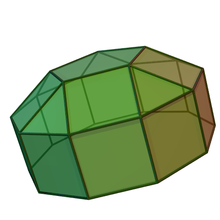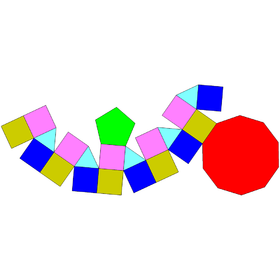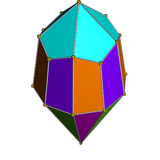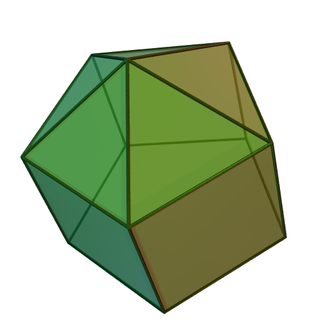
In geometry, the elongated pentagonal pyramid is one of the Johnson solids. As the name suggests, it can be constructed by elongating a pentagonal pyramid by attaching a pentagonal prism to its base.

In geometry, the triangular cupola is one of the Johnson solids. It can be seen as half a cuboctahedron.

In geometry, the square cupola, sometimes called lesser dome, is one of the Johnson solids. It can be obtained as a slice of the rhombicuboctahedron. As in all cupolae, the base polygon has twice as many edges and vertices as the top; in this case the base polygon is an octagon.

In geometry, the pentagonal rotunda is one of the Johnson solids. It can be seen as half of an icosidodecahedron, or as half of a pentagonal orthobirotunda. It has a total of 17 faces.
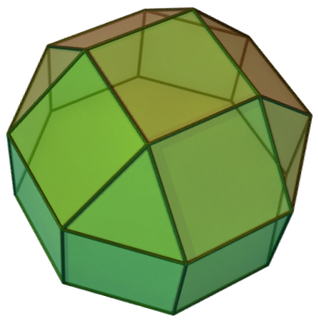
In geometry, the elongated square cupola is one of the Johnson solids. As the name suggests, it can be constructed by elongating a square cupola by attaching an octagonal prism to its base. The solid can be seen as a rhombicuboctahedron with its "lid" removed.

In geometry, the elongated pentagonal rotunda is one of the Johnson solids (J21). As the name suggests, it can be constructed by elongating a pentagonal rotunda (J6) by attaching a decagonal prism to its base. It can also be seen as an elongated pentagonal orthobirotunda (J42) with one pentagonal rotunda removed.

In geometry, the elongated pentagonal gyrobirotunda is one of the Johnson solids. As the name suggests, it can be constructed by elongating a "pentagonal gyrobirotunda," or icosidodecahedron, by inserting a decagonal prism between its congruent halves. Rotating one of the pentagonal rotundae through 36 degrees before inserting the prism yields an elongated pentagonal orthobirotunda.

In geometry, the elongated pentagonal orthobirotunda is one of the Johnson solids. Its Conway polyhedron notation is at5jP5. As the name suggests, it can be constructed by elongating a pentagonal orthobirotunda by inserting a decagonal prism between its congruent halves. Rotating one of the pentagonal rotundae through 36 degrees before inserting the prism yields the elongated pentagonal gyrobirotunda.

In geometry, the pentagonal cupola is one of the Johnson solids. It can be obtained as a slice of the rhombicosidodecahedron. The pentagonal cupola consists of 5 equilateral triangles, 5 squares, 1 pentagon, and 1 decagon.

In geometry, the elongated triangular bipyramid or triakis triangular prism is one of the Johnson solids, convex polyhedra whose faces are regular polygons. As the name suggests, it can be constructed by elongating a triangular bipyramid by inserting a triangular prism between its congruent halves.

In geometry, the gyrobifastigium is the 26th Johnson solid. It can be constructed by joining two face-regular triangular prisms along corresponding square faces, giving a quarter-turn to one prism. It is the only Johnson solid that can tile three-dimensional space.

In geometry, the pentagonal orthobicupola is one of the Johnson solids (J30). As the name suggests, it can be constructed by joining two pentagonal cupolae (J5) along their decagonal bases, matching like faces. A 36-degree rotation of one cupola before the joining yields a pentagonal gyrobicupola (J31).

In geometry, the elongated pentagonal orthobicupola or cantellated pentagonal prism is one of the Johnson solids (J38). As the name suggests, it can be constructed by elongating a pentagonal orthobicupola (J30) by inserting a decagonal prism between its two congruent halves. Rotating one of the cupolae through 36 degrees before inserting the prism yields an elongated pentagonal gyrobicupola (J39).

In geometry, the elongated pentagonal gyrobicupola is one of the Johnson solids (J39). As the name suggests, it can be constructed by elongating a pentagonal gyrobicupola (J31) by inserting a decagonal prism between its congruent halves. Rotating one of the pentagonal cupolae (J5) through 36 degrees before inserting the prism yields an elongated pentagonal orthobicupola (J38).

In geometry, the elongated triangular cupola is one of the Johnson solids. As the name suggests, it can be constructed by elongating a triangular cupola by attaching a hexagonal prism to its base.
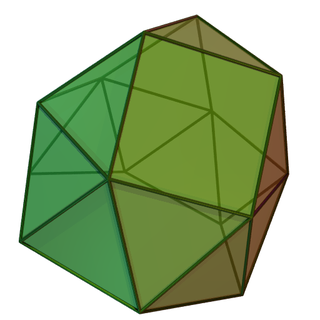
In geometry, the gyroelongated triangular cupola is one of the Johnson solids (J22). It can be constructed by attaching a hexagonal antiprism to the base of a triangular cupola (J3). This is called "gyroelongation", which means that an antiprism is joined to the base of a solid, or between the bases of more than one solid.

In geometry, the pentagonal orthocupolarotunda is one of the Johnson solids (J32). As the name suggests, it can be constructed by joining a pentagonal cupola (J5) and a pentagonal rotunda (J6) along their decagonal bases, matching the pentagonal faces. A 36-degree rotation of one of the halves before the joining yields a pentagonal gyrocupolarotunda (J33).
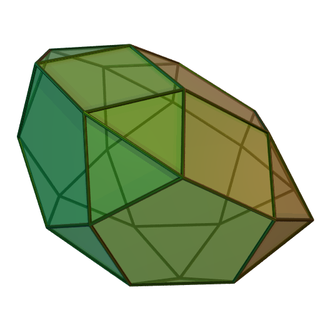
In geometry, the pentagonal gyrocupolarotunda is one of the Johnson solids (J33). Like the pentagonal orthocupolarotunda (J32), it can be constructed by joining a pentagonal cupola (J5) and a pentagonal rotunda (J6) along their decagonal bases. The difference is that in this solid, the two halves are rotated 36 degrees with respect to one another.

In geometry, the elongated pentagonal gyrocupolarotunda is one of the Johnson solids (J41). As the name suggests, it can be constructed by elongating a pentagonal gyrocupolarotunda (J33) by inserting a decagonal prism between its halves. Rotating either the pentagonal cupola (J5) or the pentagonal rotunda (J6) through 36 degrees before inserting the prism yields an elongated pentagonal orthocupolarotunda (J40).
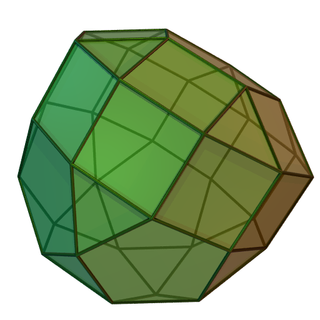
In geometry, the elongated pentagonal orthocupolarotunda is one of the Johnson solids (J40). As the name suggests, it can be constructed by elongating a pentagonal orthocupolarotunda (J32) by inserting a decagonal prism between its halves. Rotating either the cupola or the rotunda through 36 degrees before inserting the prism yields an elongated pentagonal gyrocupolarotunda (J41).
